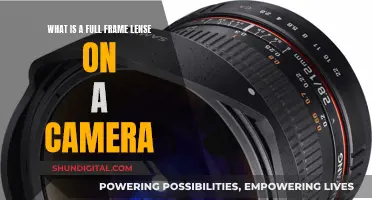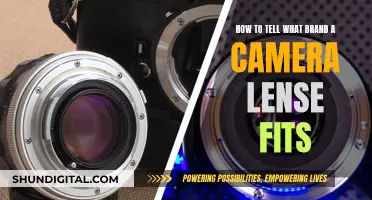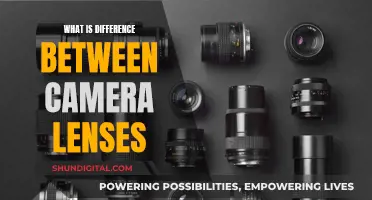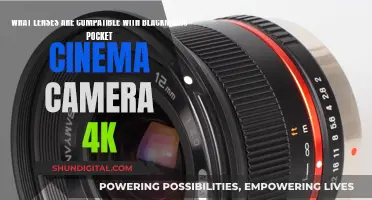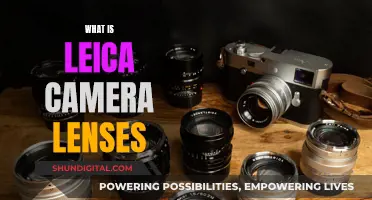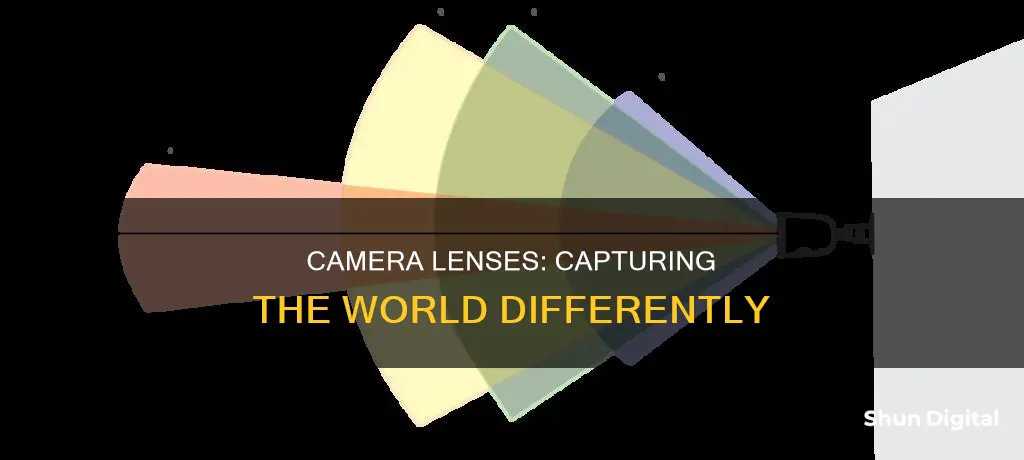
Camera lenses are arguably the most important piece of equipment a photographer can buy. Even more important than the camera itself. While the camera body is important, with its megapixels, comfortable controls, light meter, ISO range, and shutter, the lens is what focuses the light that the camera captures.
The lens you use will determine the types of photos you can take. For example, if you want to shoot at night, you will need a lens with a wide aperture. For sports or wildlife photography, a telephoto lens is ideal. The best portraits and landscapes are also taken with different lenses.
Lenses are also a more durable investment than camera bodies, which tend to go out of date quickly.
| Characteristics | Values |
|---|---|
| Lens sharpness | Sharpness is important, but not always the most important characteristic of a lens |
| Aperture | The aperture or "pupil" of the lens controls how much light enters the lens. A wider aperture lets in more light. |
| Focal length | The focal length of a lens determines how far "zoomed in" the lens is. |
| Durability | Lenses with fewer moving parts are generally more durable. |
| Weight | Heavier lenses may be more durable, but lighter lenses are easier to handle. |
| Autofocus | The autofocus feature of a lens is particularly important for sports photography. |
| Aberrations | All lenses have aberrations, but more expensive lenses have fewer. Aberrations can be corrected with software. |
| Bokeh | Bokeh refers to the quality of the out-of-focus blur in a photo. |
| Flare | High-quality lenses have coatings that minimise flare. |
| Sample variation | Some lenses have more sample variation than others, which can affect image quality. |
What You'll Learn

Camera lenses are more important than the camera body
The camera lens is arguably the most important piece of equipment for a photographer. While the camera body has its role, lenses are fundamental to the image-making process and can elevate image quality, control what you shoot, and last longer.
Image Quality
The lens plays a critical role in image quality. Lenses with high-quality glass and advanced manufacturing techniques minimise issues like chromatic aberration, distortion, and vignetting, resulting in sharper images. Expensive lenses also tend to be sharper across the entire image frame.
Control Over Your Photography
Lenses determine what and how you shoot. The focal length and aperture of a lens define the field of view, depth of field, and low-light capabilities, enabling specific types of photography like wildlife, sports, or portraiture.
Longevity and Investment
Lenses generally last longer than camera bodies due to their durability and slower technological obsolescence. They retain their resale value better and can be used across multiple camera bodies. As such, lenses often offer a better long-term investment.
The Bottom Line
While camera bodies have their role in autofocus, ergonomics, and resolution, the lens is the key component that controls image quality and the types of photos you can capture. Upgrading your lens can have a more noticeable impact on your photography, making it a wiser choice in most cases.
The High Cost of Camera Lenses: Why So Expensive?
You may want to see also

Lenses control what you can shoot
Lenses play a crucial role in determining what you can shoot, as they control the focal length and depth of field. Different lenses enable you to capture various subjects and situations. For instance, a wide aperture lens is ideal for night photography, while a telephoto lens is perfect for sports or wildlife photography. The right lens choice becomes even more critical when you don't have the "right" lens for a specific subject, making your task more challenging.
The focal length of a lens determines how "zoomed in" it is, with lenses categorised as prime or zoom. Prime lenses have a fixed focal length, like the popular 50mm lens, while zoom lenses cover a range of focal lengths, such as the common 18-55mm kit lens. The focal length also influences the apparent magnification of your subject, with longer focal lengths making the subject appear closer and vice versa.
Additionally, the maximum aperture of a lens, denoted by the "f-number," is another critical factor. A larger aperture, such as f/1.4 or f/2.8, allows more light to enter the lens, creating a ""shallow focus" effect with a blurred background. This effect is commonly used in portraiture and still life photography. On the other hand, smaller apertures, like f/16 or f/22, can add blur to the entire image and make it darker.
When choosing a lens, it's essential to consider factors beyond sharpness and image quality. Size, weight, autofocus capabilities, durability, ergonomics, and construction quality are all important aspects that can impact your photography experience and the types of shots you can capture.
While both the camera body and the lens are essential, with neither being effective without the other, the lens often takes precedence due to its impact on the final image and the variety of shooting situations it enables.
Fungus in Camera Lenses: Causes and Prevention Tips
You may want to see also

Lens sharpness is important, but not everything
While lens sharpness is important, it is not the only factor that determines the quality of a photograph. In fact, there are several other characteristics of a lens that can have a more significant impact on the final image. Here are some reasons why lens sharpness, while important, should not be the sole focus of photographers:
- Artistic Expression: Softer lenses or those with lower sharpness can often add a dreamy, nostalgic, or emotional aesthetic to photographs. This is particularly true for film photography, where softer images can evoke a sense of imperfection and nostalgia. Artists throughout history, such as the impressionists, have used blurry or unsharp brushstrokes to evoke a particular mood or feeling in their paintings.
- Emotion and Movement: Blurry or out-of-focus photographs can convey more emotion and a sense of movement. Sometimes, a deliberate lack of sharpness can enhance the mood or feeling that a photographer is trying to capture.
- Viewing Medium: The medium on which photographs are viewed also plays a role in the perception of sharpness. When photos are viewed on smartphone screens or small prints, the level of sharpness becomes less noticeable. Unless photos are printed in large formats or viewed at high magnifications, subtle differences in sharpness may not be apparent to most viewers.
- Other Lens Characteristics: Lenses have various characteristics besides sharpness that contribute to the overall image quality. These include local contrast, color purity, freedom from distortion, bokeh (the quality of out-of-focus blur), flare control, and more. A lens with excellent performance in these areas can produce stunning images, even if its sharpness is not the absolute sharpest.
- Photographer's Skill: The skill and technique of the photographer play a far more significant role in achieving sharp images than the lens alone. Factors such as accurate focus, lighting, depth of field, subject and camera movement, and composition have a more pronounced impact on the sharpness and overall quality of a photograph.
- Subject Matter and Composition: The subject being photographed and its placement within the frame are crucial. In most cases, the main subject should be in sharp focus, while the corners or edges of the image may be less critical. Placing important elements along the edges or corners can distract viewers and weaken the overall composition.
- Format and Sensor Size: The format and sensor size of the camera also influence the apparent sharpness of an image. Larger formats, such as medium format cameras, inherently capture sharper images compared to smaller formats like 35mm. Additionally, the sensor size affects the effective focal length and apparent sharpness, with smaller sensors resulting in images that appear more zoomed in.
- Practical Considerations: Other practical considerations, such as the weight, size, durability, autofocus performance, and price of a lens, may take precedence over absolute sharpness for many photographers. A lighter, more durable lens with slightly lower sharpness may be preferred for travel or outdoor photography.
- Creative Constraints: Using cameras with non-interchangeable lenses or limiting oneself to a single lens can foster creativity by forcing photographers to work within constraints. This can lead to more innovative compositions and a greater focus on the artistic aspects of photography rather than gear.
While lens sharpness is important and can enhance image quality, it should not be the sole determining factor when choosing a lens. Photographers should consider their specific needs, subject matter, and artistic vision when selecting lenses. Other characteristics of the lens and the photographer's skill will also play significant roles in the final image quality.
RF Lenses: The Future of Mirrorless Photography?
You may want to see also

Lens aberrations can be corrected with software
Chromatic Aberration
Chromatic aberration is a colour problem, where red and green colour shifts occur at the edge of the screen, or a purple halo appears around high-contrast detail. This is caused by the different wavelengths of colour in light travelling at different speeds and refracting at different degrees when passing through a lens. Chromatic aberration is particularly hard to correct via optical design alone, but enabling features like the Digital Lens Optimizer (DLO) or chromatic aberration correction function will correct chromatic aberration more effectively.
Distortion
Distortion occurs at extreme focal lengths and is visible on subjects with straight lines. Depending on the lens, these lines may seem to curve inward (barrel distortion) or outward (pincushion distortion). This can be corrected with photo editing software or RAW development software, although the process will crop off the edges of the image very slightly.
Vignetting
Vignetting is a darkening around the corners of the image, caused by the characteristics of the lens and image sensor. This can be corrected with features like Peripheral Illumination Correction, which brightens up the corners of the image.
While lens aberrations can be corrected with software, it is worth noting that this will increase image noise towards the corners of the image, as digitally brightening an image amplifies the signal and noise equally. It is also worth noting that some aberrations, like axial chromatic aberration, are uncorrectable.
In summary, while lenses are incredibly important for photographers, software tools can help correct some of the common aberrations that occur, improving the overall quality of images.
Understanding Camera Lenses: Magnification Options for Photographers
You may want to see also

Camera bodies are disposable
While it is important to have a good camera body with a bucket-load of megapixels, comfortable controls, a good light meter, a solid ISO range, reliable noise reduction, and a precise shutter, the lens is the most important part of your camera. Camera bodies are disposable because they are prone to becoming outdated every few years due to new developments and technologies. On the other hand, lenses are updated much less frequently and can last for multiple camera bodies if they are compatible and well-maintained.
Lenses are more important than the camera body because they control what you can shoot. A camera without a lens is just a dumb, image-capturing brick. Lenses with different specifications enable you to shoot different subjects and situations. For instance, you would need a lens with a wide aperture to shoot at night, while a telephoto lens is ideal for sports or wildlife photography. The right lens is crucial for getting the shot you want.
Additionally, lenses have a greater impact on image quality than camera bodies. While a high-end camera body can produce sharper images, especially in low-light conditions, the lens plays a more significant role in the overall image output. A good lens can elevate the quality of images captured by a low-end camera body, while a poor-quality lens can degrade the images taken by a high-end camera.
Furthermore, lenses are a better investment than camera bodies due to their durability and slower rate of technological change. Lenses are more durable than camera bodies, which have a limited number of actuations before the shutter fails. Lens technology advances at a slower pace compared to camera bodies, and a lens can often be used for decades with different camera bodies. Lenses also retain a higher percentage of their resale value compared to camera bodies, which depreciate quickly as newer models are released.
In conclusion, while both camera bodies and lenses are important, the lens is the more crucial component. Camera bodies are more disposable, while lenses have a longer lifespan, a greater impact on image quality, and a higher return on investment.
The Power of Three: Capturing Moments with Camera Lenses
You may want to see also



